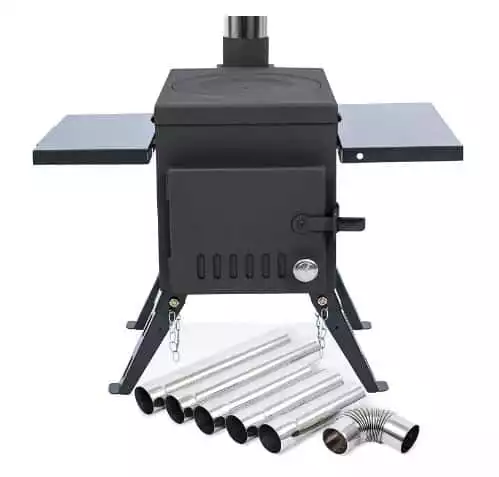- How to Heat Your House with a Wood-burning Stove - December 20, 2021
- 17 Old-Timey Sayings We Still Love to Use Today - September 8, 2020
- 19th Century Recipes for a Hearty Breakfast - July 14, 2017
During the 1970s, and into the 80s, the United States went through what is known today as the Gas Crisis or the Oil Crisis of 1973. The members of the Organization of Arab Petroleum Exporting Countries proclaimed an oil embargo in response to the United States’ support for Israel during the Yom Kippur War. During this time, the price of natural gas shot up.
My parents’ house uses a furnace powered by natural gas. My dad, in an effort to save money, decided we would heat the house by a wood-burning stove fitted into the living room fireplace. Sounds pretty cool, right?
There were/are lots of good things about burning wood, one of the most significant being that wood is a renewable energy source.
Another benefit, perhaps unintentional, of my Dad heating our house with wood was that my brothers and I all ended up being exceptional fire builders. If the zombie apocalypse were to ever arrive, we would be the ones in the group building and tending the fires.
We know how to build a fire that will last through most of the night, and how to stoke up the glowing embers in the morning.
Dad also took us wood cutting expeditions to my Grandparents’ woods. Looking back now, I realize that my Dad was a DIY aficionado before DIY was cool – or even a thing.
The only kind of not so good thing about heating our 1970s ranch style house with a wood burning stove was that it wasn’t built for that so there wasn’t any system to properly vent the heat into the entire house.
The living room, where the fire place was would be 80 degrees or so (Fahrenheit) while my bedroom, which is furthest away, would be somewhere around 40 degrees.
To this day, I cannot sleep in hot, or even normal temperature rooms.
So what if you want to heat your house with wood today?
One of the challenges of heating a home with a wood stove is properly dispersing the heat throughout the house (something my Dad and our house wasn’t really able to accomplish).
One dispersal method is to use a fan on top of the stove – if your stove is free standing and not inserted into a fireplace as ours was. Rising heat from the stove makes the fan blades turn and push heat outward.
Another option is a plug-in blower. You can position the blower beneath or next to the stove to push the heat where you want it to go. Some wood stove homes use multiple fans in different rooms, strategically positioned to maximize heat flow. They can be ceiling fans or small fans mounted at the corners of doorways. Our house had none of these which is why the heat pretty much hung around in the living room.
What if you have a two-story home and want to use a wood stove to provide heat?
This is definitely possible though it does take some planning and construction.
Wood stoves should be installed on the lower level in two-story homes for the simple reason that heat rises. If possible, you should cut an air duct through the floor somewhere near the stove.
Most often you’ll be able to install a fan inside the floor (between the ceiling below and the floor above) that will blow the heat upward through a grate. This simple solution can heat the entire upper floor.
If you are not installing your wood stove into a fireplace as my Dad did, you should check the building and fire code regulations in your state for wall clearance and pipe diameter regulations. In this instance, you’ll also need to select a proper hearth and wall shield for your new stove.
Wood burning stoves are rated by how big of a space they are able to heat. You’ll likely need a stove that is rated for at least 2,000 square feet to heat a two-story house.
And you’ll need a chimney if your house doesn’t already have one. The chimney should be vented out horizontally through the wall about 12 to 24 inches above the stove. The rest of the chimney pipe should then run up the exterior of the house to extend above the roofline.
There are lots of choices for chimney pipe.
Interior chimney pipe is usually single wall, which means it also radiates heat. Pipe that does not radiate heat and is safe to use near other materials is called double or triple-wall pipe.
For some inspiration, or if you don’t believe that a large house can be heated with only wood, here is a great article on Mother Earth News about a couple who built their dream house in rural Maine with only a single wood burning stove as a heat source.
Despite our wood burning stove’s inefficiencies, I’m actually really glad to have grown up in a house heated with wood. The glow of a fire on a winter’s day or night is one of the most comforting things in the world, I think. Also, our wood stove provided our family cat with the perfect place to spend the long cold winter in Northern Ohio. Meow.
Wood-burning stoves are a traditional heating choice, using firewood as the fuel source and creating warmth through radiant heat. Check out these wood-burning stove options at Amazon.com.

